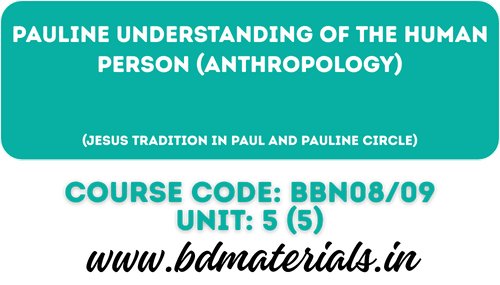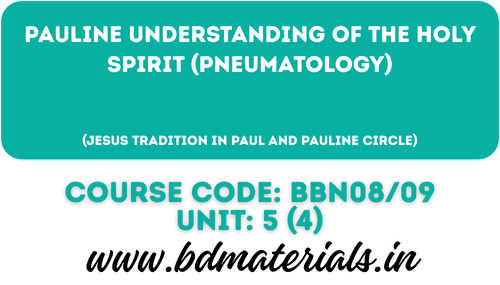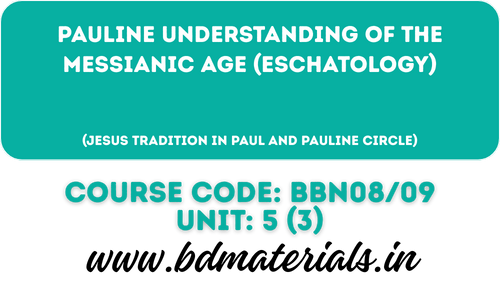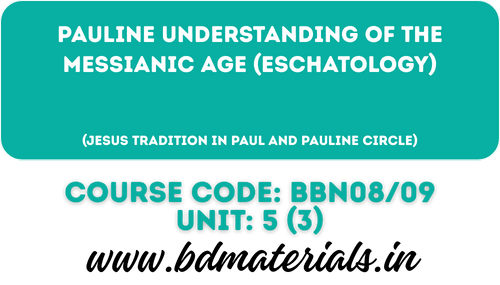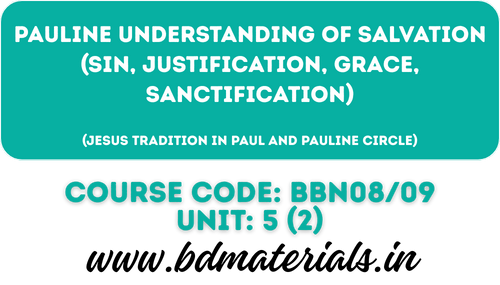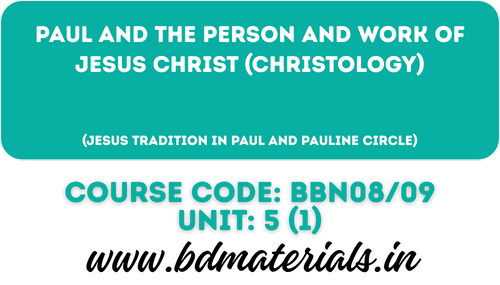Sources for the Study of the Pauline Tradition
The Book of Acts serves as one of the main sources for the life of Paul and Pauline tradition. Since it is considered to be the oldest Christian writing that aspires to give a historical presentation. With-out the book of Acts, we would know very little about the origin of the Christian church. The book of Acts portrays the calling of Paul to be a worldwide witness (9:1-20). Paul dominates the narrative, until he arrives in Rome and spends two years there in custody, from Acts 15:40 till the end of the book.1
Pauline Epistles
Paul’s own letters cannot be ignored to study Pauline tradition which was in fact the earliest Christian New Testament writings. The New Testament canon contains thirteen epistles ascribed to Paul:2 Romans, Galatians, 1 and 2 Corinthians, 1 and 2 Thessalonians, Philippians, Philemon, Colossians, Ephesians, 1 and 2 Timothy and Titus. Among the Pauline letters the so-called Pastoral Epistles (land 2 Tim., Titus) form a special group. We may also classify the epistles which Paul wrote in prison (Philippians, Colossians, Philemon and Ephesians) called as “prison epistles”. However this is not a consensus view of all the modern scholars. After the beginning of the nineteenth century, questions were raised about the Pauline origin, first of the Pastorals then of those of the Thessalonians, Ephesians, Philemon and Colossians. F. C. Baur and the Tubingen School considered only the four so-called chief letters- Galatians, 1 and 2 Corinthians, Romans to be authentic documents of the apostle, because only these letters could be understood as witnesses for the struggle of Paul against “Judaizing.” In addition to the four main letters, 1 Thessalonians, Philippians and Philemon are to be regarded as genuine.3
1. Paul’s Biographical Details in His Letters
The consistent history on the life of Paul can be derived with the help of the accounts found in the book of Acts and in his own letters. His epistles contain very little information about Paul’s past; however. it cannot be ignored. Although the book of Acts also recounts Paul’s career providing more basic data but found several parts of Paul’s life out of its narrative, such as his probable but undocumented execution in Rome.
1.1. Early Life
Paul was a child of his time, both internal and external sources tell us about his life and background, although, it is very limited. Nowhere the bible mentions the date and birthplace of Paul, it was totally unfamiliar to the people of the first century. He came to the picture in Jerusalem as a Christian’s persecutor. The text simply mentions that he was brought up in Tarsus, the capital of Cilicia as a Jew (cf. Acts 21 :39); circumcised on the eighth day, a member of the people of Israel, of the tribe of Benjamin, a Hebrew born of Hebrews; to the law, a Pharisee (Phil 3:5). Also, he was educated by a Jewish Rabbi called Gamaliel (Acts 22:20). However, due to lack of accurate evidence about his birth from the text, most scholars locate Saul’s birth sometime between CE 6 and 1 0, and some scholars suggested the birth of Paul in the middle ground of CE 8.4
1.2. Paul’s Family
Scriptural evidences as to when Paul’s family arrived in Tarsus and the identity of his parents are not seen. According to Jerome, his family came from Gischala in Galilee,5 and while Saul was just a baby when the family arrived in Tarsus. There is also a suggestion that Paul’s family had lived in Tarsus for many generations. So Paul’s parents did not come from Gischala but Paul was born in Tarsus as Luke hints us (cf. 21 :39).6 The later hypothesis could be probable since the first century historians like Strabo and Josephus were of the view that the Jews were already in almost all the cities during Paul’s time. Regarding Paul’s mother it is suggested that she was a devoted lady, devoted for the cause of Jewish law and culture and it is due to her that Paul became zealous of his Jewish origin. It is also assumed that Paul’s father was a Cilician Libertine. It is also probable that Paul inherited his family’s business as a “skenopoios” – “tentmakers” or “leather worker” as he accepted tent making (Acts 18:3). The Pharisaic tradition also prescribed that a father teaches his son a trade. Paul had a married sister (cf. Acts 23:16) and a brother— Rufus (cf. Rom 16:13).
The Book of Acts indicates that Paul was a Roman citizen by birth, more affirmatively describing his father as such, but some scholars have taken issue with the evidence presented by the text (Acts 16:37; 22:25-29).7 There is paucity of sources about Paul’s family from the Bible though Paul’s nephew is mentioned in Acts 23:16 along with Paul indirect reference to his father by saying he, Paul, was “a Pharisee, the son of a Pharisee” (Acts 23:6) and later his mother in Romans 16:13 as among those at Rome. In Romans 16:7, he states that his relatives, Andronicus and Junia, were Christians before he was and were prominent among the apostles. Acts 23:16 recounts some of his family may have resided in Jerusalem since later the son of one of his sisters saved his life there. Nothing is known of his background until the martyrdom of Stephen where young man Saul would follow the executioners (Acts 7:58-60; 22:20).8 Paul confesses that “beyond measure” he persecuted the church of God prior to his conversion (Gal 1: 13-14, Phil 8:1-3).
1.2.1. Paul Marital Status
Paul’s writings make no mention of a marriage, and neither does Luke in the Acts of Apostles. In the First Letter to the Corinthians, he himself hints us of unmarried, he says “to the unmarried and the widows I say that it is well for them to remain unmarried as I am” (7:8). However, the Jews practice was that a young Jew was dedicated from the age of thirteen to observe the commandments, at fifteen to Talmud, and at eighteen the wedding awaited him. Thus, Alain Decaux further adds:
The issue arose not only for religious reasons but a also because of a physiological fact: beyond eighteen years of age, one risked seeing the young man lose himself in dangerous adventures. Marriage protected him. Moreover, the Torah formally invited the Jew to establish a family. It is hard to imagine Saul dispensing himself from this obligation.9
The Greek word agamos, which is translated here as unmarried, in other words could be without husband or wife — also designates those who have never taken a wife, the widowed, and separated spouses. If so, was Paul married, did Paul at an unknown time lose his wife? It should be mentioned that the historians and exegetes who believe in this marriage are minority, but their argument is on solid ground.10
1.3. Paul’s Name
It has been popularly assumed that Paul’s name was changed when he converted from Judaism to Christianity. His Jewish name was “Saul” in Hebrew Sa’ul/Shauol =asked of God and in Greek Saulos, recalled the first King of Israel, incontestably the greatest man of the tribe of Benjamin. Tho book of Acts mentioned that Paul as a Homan citizen, he also bore the Latin name of “Paul” in biblical Greek Paulos and in Latin Paulus means small (c.f. Acts 16:37, 33:25-28), Tho Jews of that time have two names, ono Hebrew, the other Latin or Greek. Thus, we know from his biography and from Acts that Paul could speak Hebrew and Aramaic. Modern scholarship suggests that Koine Greek was his first language from his diverse background.11 The former name was probably used in the Jewish circles and the latter in the Roman circles. for he possessed a Roman citizenship as well.
Decaux mentions that the name “Paul” was changed after an interaction with the proconsul. Sergius Paulus, an intelligent man (Acts 13:7). Tho proconsul, wanted to hoar Paul but it was Elymas, a magician who tried to distract him. So, Elymas became blind. When Proconsul saw what had happened, he believed his Lord (Acts 13:8-12). From that time his name was changed from Paulus to Paul. Perhaps that led Saul to abandon his Jewish name. It can also be assumed that since there wore many nations, people and languages that coexisted, it is highly possible that the substitution of one name for another was common practice under Roman standards. Another striking example is — Simon, who was also called Cephas was later called Petrus.12
1.4. Paul’s Conversion
According to Acts, on the road to Damascus Paul had a vision, saw a bright light, heard a voice calling him “Saul” in Aramaic (Acts 26: 1 4) and encountering Jesus there resulted his conversion. The Damascus experience alone cannot be just considered as starting point of his life alone. After the Damascus experience Paul became a transformed man and we cannot ignore the diverse culture which he possessed within himself for which this nature has become a tool for his transformation. The Jewish blood and the Jewish instructions from a Jewish teacher took him to zealously and become a source of destruction when his Jewishness could not tolerate the new movement Christianity. With the permission of the Roman government, he wanted to uproot it so that the supremacy of the Jewish religion could be established and the new religion of Christianity becomes as powerless. His initial reaction to the newly formed Christian movement was to zealously persecute Its early followers and to violently attempt to destroy the movement. Paul’s dramatic conversion while on the road to Damascus was clearly a life-altering event for him, changing him from being one of the early movement’s most ardent persecutors to being one of its most fervent supporters.13
Paul’s conversion may be dated to CE 31—3614 by his reference to it in one of his letters. It took place on the road to Damascus where he was reported having experienced a vision of the resurrected Jesus. The account says that “he [Saul] fell to the earth, and heard a voice saying unto him, Saul, Saul, why do you persecute me?” He asked, ‘Who are you, Lord?’ The reply came, ‘l am Jesus, whom you are persecuting” (Acts 9:4-5). Being momentarily blinded by the vision for three days and he was led into the city to meet Ananias. Although Ananias had heard much about Saul and was justifiably scared, he too obeyed the Lord and took Saul in. Ananias laid hands on Saul and healed him of his temporary blindness. This life-changing experience and revelation convinced Paul that God indeed had chosen Jesus to be the promised Messiah. Luke, the author of Acts of the Apostles, likely learned of his conversion from Paul, from the church in Jerusalem, or from the church of Antioch.15
1.5. Early Ministry
The book of Acts states that after his conversion, Paul went to Damascus and was healed of his blindness and baptized by Ananias of Damascus. It was in Damascus that he barely escaped death which is found in 2 Corinthians 1 1:32. On contrary, Galatians 1:17 says that he went first to Arabia, and then came back to Damascus.16 Paul’s trip to Arabia is not mentioned anywhere else in the Bible, and some supposed he actually travelled to Mt. Sinai for meditations in the desert.17 Paul went to stay in Jerusalem three years after his conversion. During his fifteen days with Cephas he did not see anyone but James and Peter who he acknowledged in Galatians 1:20, “before God, I do not lie.” For Paul “in Christ God was reconciling the world to himself, not counting their trespasses against them, and entrusting the message of reconciliation to us” (2Cor.5:19). “Jesus did not need a biography.”18
1.6. Paul Missionary Journeys19
Luke in his second work systematically arranges Paul’s travel into three separate journeys. A detailed treatment of various missionaries journey is not taken into consideration but a brief review of the periods and places were highlighted below:
1.6.1. First Missionary Journey
Acts 1 3:1-14:28 records the First missionary journey. Paul was accompanied by Barnabas and John Mark. The journey probably took place in 47 CE. In the first journey Paul and Barnabas were commissioned. In which the relationship between the Jewish Christian and Gentiles Christians was affected with the conversion. When both the Jews and ‘God-fearing’ gentiles gathered and invited to share more about Jesus, this arouse anger to some influential Jews who spoke against them. The problems were circumcision, observation of Mosaic Law and dietary matters. For this the council of Jerusalem was held to decide against the obligatory circumcision and observance of Mosaic Law for the Gentile Christians.
1.6.2. Second Missionary Journey
From Acts 15:36-18:23 we find Paul Second Missionary journey which was accompanied by Silas. This journey probably took place in between CE 50-52. Paul and his companion missionaries too were not free from arguments regarding the new religion to bring gentiles and Jews together. Miraculous power of God transcends all human rationale and philosophies. Churches were planted with many faithful followers. Paul wrote first and second Thessalonians from Corinth during his joumey.
1.6.3. Third Missionary Journey
The Third journey is recorded in Acts This journey took place probably in 56 CE. This journey was to go around strengthening, teaching and rebuking the believers. During his stay in Ephesus, Paul wrote four letters to the church in Corinth admonishing them for their pagan behaviour. The letter to Galatians, Philippians, and first Corinthians found to be written from Ephesus, second Corinthians from Macedonia and Romans from Corinth.
1.7. Journey to Jerusalem and the End of his Life at Rome
After Paul’s arrival in Jerusalem at the end of his third missionary journey, he became involved in a serious conflict with some “Asian Jews.” The conflict eventually led to Paul’s arrest. Paul was taken to the Governor Felix in Caesarea in 58 CE, where he spent 2 years
in prison. Paul appealed to Caesar in Rome and he finally arrived in Rome. He was under house arrest for a couple more years in which he wrote many of his letters. Paul was released from prison and travelled for a couple more years in much of the same territory that he travelled before. The exact year of his death is not known. He probably died in prison as a martyr in 67 CE.20 In June 2009, Pope Benedict XVI announces excavation results concerning the tomb of Paul at Basilica of Saint Paul Outside the Walls.21
2. Portrait of Paul in the Acts of Apostles
Paul is referred to as the central figure of the book of Acts and in Pauline Letters. The literature of Acts of Apostles talks about Paurs early life as well as his post conversion period. There is particular mentioned about Paul as God’s basically chosen servant even before he was conceived in his mother’s womb. Paul’s extreme conviction is also found, “l will show how much he has to suffer for my sake” in Acts 9:10. Despite of his limitations from his personal life Paul claimed that the life of Jesus and his ministry was not only in this world itself but Paul took the minds of his readers from this world to the other world.
According to Raymond Brown, it is possible that Luke, a minor figure who travelled with Paul for some time, wrote the third gospel and the book of Acts decades after Paul’s death.22 In Acts of Apostles, we could find Paul begins his life as a torturer of Christians and has been presented as a jealous Jew who works for Judaism and a Pharisee who is faithful in following the Torah. For this reason we could see the devastating nature of his jealous behaviours as a torturer.23 At least the event of Paul’s conversion has been stated twice and the detail narration has been mentioned in Acts 9. The author of Acts of the Apostles has written the elementary life event of Paul from the beginning, his conversion, his post conversion episode and till the end at Rome. Thus, Acts become basic foundation book for Paul.
It should be noted that the author of the third gospel and Acts nowhere claims to have been “inspired” by a higher source to write his accounts. Independent archaeological research has solidified the authenticity and the historical reliability of the New Testament. Some of the discoveries include: Luke refers to Lysanias as being the tetrarch of Abilene at the beginning of John the Baptist ministry, circa 27 CE (Lk 3:1). Historians accused Luke of being in error, noting that the only Lysanias known was the one killed in 36 CE. Now, however, an inscription found near Damascus refers to “Freedman of Lysanias the tetrarch” and is dated from 14 and 29 CE Paul, writing to the Romans, speaks of the city treasurer Erastus (Rom 16:23). In 1929 excavation in Corinth unearthed a pavement inscribed with these words: ERAS TVS PRO: AED: P: STRAVIT: (“Erastus curator of public buildings laid this pavement at his own expense”).24 Luke mentions a riot in the city of Ephesus which took place in a theatre (Acts 19:23-41). The theatre has now been excavated and has a seating capacity of 25,000.
Acts 21 records an incident which broke out between Paul and certain Jews from Asia. These Jews accused Paul of defiling the Temple by allowing Trophimus, a Gentile, to enter it. In 1871, Greek inscriptions were found, now housed in Istanbul which read:
No foreigner may enter within the barricade which surrounds the temple and enclosure. Anyone who is caught doing so will have himself to thank for his ensuing death.
Luke addresses Gallio with the title Proconsul (Acts 18:12). A Delphi inscription verifies this when it states, “As Lucius Junius Gallio, my friend, and the Proconsul of Achaia …” Luke calls Publicus, the chief man of Malta, “First man of the Island” (Acts 28:7). Inscriptions now found do confirm Publicus as the “First man” (Josh McDowell, The Best of Josh Mcdowell: A Ready Defense, 1 10-111).
Ramsey stated: “Luke is a historian of the first rank; not merely are his statements of fact trustworthy…. This author should be placed along with the very greatest of historians.” Ramsey further said: “Luke is unsurpassed in respects of its trustworthiness” (Josh McDowell, The Best of Josh Mcdowell: A Ready Defense, 108-109). Thus, Acts become very keen in describing historical facts and figures for it says, ‘Who was and who were.” Paul also made many journeys and many people were converted, Paul dropped some and took along with him some of them for his ministry. That is how Acts is regarded as history of New Testament.
Marshal talks about the “essential” reliability of Acts regarding historical matters and not its complete reliability.25 Sherwin-White, for instance believes that “Luke makes mistakes, but the main trust of his book is to demonstrate that for the most part Luke portrays the first century Roman scene accurately.”26 But Luke was not dependent alone upon his personal investigations for the accuracy of his record. He says that he closely traced all things from above. The words ‘from above” are from a Greek word translated “from the very first,” in the Authorized Version. The word occurs in John 3:31; 19:11; James 1:17; 3:15, 17, and is in every instance translated “from above.” It is used often in contrast to a word which means “from beneath.” Paul had doubtless heard the account of the institution of the Lord’s Supper from the eleven, but he also had it by revelation from the Lord (1 Cor. 11:23). He had received his gospel by direct revelation in Arabia, and this was his check upon the gospel he heard at Jerusalem from the apostles. So Luke claims to have closely investigated the facts he had received, and to have done so through the inspiration of the Holy Spirit, which fact guarantees the absolute accuracy of the record (Luke 1:1-4).27
In Acts we find that the speeches of Paul were made to the Christians. There is a so general agreement among New Testament scholars that the speeches found in Acts are either the creations or adoptions of Luke.28 Paul’s speeches had been described to this kind of sufferings to strengthen them to withstand for the sake of Christ. Paul’s speeches are found in Acts and from these speeches we can detect sources of the historical events like Jerusalem Council theme: “Issue of Circumcision.” Circumcision is emphasis in Acts but in Pauline Epistles, it is theological talk as “circumcision of the heart.”29
3. Apocryphal Texts: The Acts of Paul and Thecla
The word ‘Apocrypha’ is derived from Latin word apocrypha scripta ‘hidden writings.’ ‘Apocryphal’ means ‘widely circulated but unlikely to be true.’30 The New Testament apocrypha are number of writings by early Christians that claimed to be account of Jesus and his teachings, the nature of God or the teachings of his apostles and their lives. The general term is usually applied to the books that were considered by the church as useful but not divinely inspired.31 Martyrdom or Consummation (martyrion teleiosis) of the various apostles in the times of Christian antiquity under the “Apocryphal acts of apostles or deeds” texts found to have been widely spread and manifold literature. The main purposes of apocryphal writings were diffusion with the Gnostic schools and setting up against the universal tradition of the apostles in order to weaken their confidence. As commented by Lipsius:
whom we follow for the most part, these Gnostic productions, apart from any more or less marked assertion of heretical dogmas or rules of life, betray their real origin by the overgrowths of a luxuriant imagination, by their highly colored pictures, and by their passionate love for mythical additions and adornments in excess even of the popular belief in signs and wonders.32
Often used by scholars is the term pseudepigrapha or ‘falsely inscribed’ or ‘falsely attributed’ in the sense that the writings were written by an anonymous author who appended the name of the apostle to his work, such as the gospel of Peter; almost all books in both Old Testament and New Testament called apocrypha in the Protestant traditions are pseudepigrapha. In the catholic and orthodox traditions, what are called the apocrypha by Protestants include the deutero canonical books: in the catholic tradition the term apocrypha is synonymous with what the Protestants would called the pseudepigrapha, the latter term which is almost exclusively used by the scholars.33
3.1. The Acts of Paul and Thecla
As early as the second century numerous legendary reports concerning the fates of the apostles were in circulation. The real history of the lives and deaths of most of the apostles was being shrouded in obscurity, a pious imagination was very early busily employed in filling up the large lacunae left in the historical reminiscences of the church. The second century document Acts of Paul (ActPl) written by presbyter of Asia, evidence the two kinds of Paulinism which scholars distinguish in the post Pauline literature. The first concerns the image of Paul; the second concerns the presence of Pauline texts, ideas and theology. A document may demonstrate one or both sorts of Paulinism. Certainly, the ActPl depicts an image of Paul in this description of his physical aspect.34 As commented by R.J. Bauckham about physiognomy of apostle Paul that it is not a surprising feature that might preserve the memory of the history. Even though the complete texts had not survive because of the extract work and circulation the Acts of Paul and Thecla, 3 Corinthians and the Martyrdom of Paul, these parts are still extant, but most of the rest of the work survives only in fragmentary form.35
The story of Thecla recounts of a young woman of a well known family in Iconium, who accepted Paul’s message, especially its emphasis on the need to abstain from sexual relations, and breaks off her engagement and followed Paul. Thecla was miraculously saved when she was condemned to be burned at the stake and accompanies Paul to (Pisidian) Antioch, where she repulses the advances of a city official, is thrown to the wild beasts in the arena and again is miraculously preserved. After this experience Paul permits her to become a teacher, she returns to Iconium, then moves to (Isaurian) Seleucia and spends the rest of her life as a successful evangelist and teacher.36 Paul’s commission to Thecla seems to contradict Paul’s instruction to women in 1 Timothy 2:11-15. MacDonald and others suggest Thecla may be an example of a woman who continued to exercise a teaching role in liberating strand of Pauline Christianity agreeing with several texts which suggest women exercised leadership in Pauline churches (e g. Rom 16:1, 3, c.f. Acts 18:26-27; phil 4:2). Thecla’s teaching activity explicitly transgresses the limits Imposed by the Pastoral Epistles and her main work which would cause scandal in the great church.37 The writer portrayed the miraculous baptism of Thecla, for God himself comes to perform the rite. Though she was the one who threw herself into the water in fact it was God who did the divine baptizing. In the ActPl, Thecla appears as a special case for God himself baptized her and covers her nakedness to proof Gods presence in her life and ministry.38
In the most celebrated of the ActPI, known as the Acts of Paul and Thecla (ActPlThecla), Paul turns a certain Thecla away from her fiancé Thamyris, to embrace Christianity and chastity. The jealous Thamyris takes his revenge by stirring the mobs and the authorities against both his fiancée and the Apostle on by counsel of Demas and Hermogenes denounced the apostle for having cheated him out of his bride.39 According to Acta “the commission of Paul to Thecla in ActPl, 16(41 ), “Go teach and teach the word of God” let Tertullian to argue who was concerned to disallow appeal to the story of Thecla for evidence said that it seems very likely that the author incorporated in his work traditions and legends that already circulated orally in the Pauline churches of Asia Minor and for the Acts of Paul makes no claim to be written by Paul.40 Macdonald appeals to Tertullian testimony (bapt.17) that women were using the ActPl to claim the right to teach and to baptize.41 According to D.R. Macdonald, Acts of Paul and Thecla (ActPlThecla), along with the Ephesians Episode (EpEp) and Martyrdom of Paul (MartPO were originally oral legends chiefly transmitted by women who held to an apocalyptic Christianity akin to the Montanist movement. These women storytellers scorned the household and sought autonomy from male domination through chastity. A second century writers recognized the danger of the legends extreme apocalyptic view which resulted in the breakdown of the household; so he responded with the Pastoral Epistles, his own rewriting of Paul’s image.42
Thus, Macdonald refers to the study of L. Rademacher (1918) who attempts to show a relationship between Thecla and the story of Hippolytus and Phaedra, focusing on the idea of chastity and Athenian legend of Hagnodica by Hyginus. Macdonald remarks that these stories obviously were oral tales about women who broke traditional barriers against their professional pursuits.43 Since 1980 several authors Davies, Carle, Burrus, Kraemer, Dagron and MAcDonald come to conclusion that the Thecla story especially the episode at Antioch, reveals women’s point of view, suggesting the story told by, for, amongst women. P.W. Dunn viewed that the ActPl does not represent only woman’s point of view, nor that it was told in exclusrvely in women’s communities. Further, commented that men were cast in negative light but not all men.44 Davies adds that the author of ActPIThecla must be a woman who wrote not out of sympathy for women but out of personal experience.45 Thus, concludes that interpreters must ignore every indication to contrary and to exaggerate the significance of passages which might have expressed sympathy towards women and antipathy towards men.
Many attempts have put forward to key out good historical traditions behind these narratives about Paul. Most probably Thecla was a real person who was a convert of Paul at Iconium and well recalled as a prominent Christian leader in that area, but it is impossible to tell whether anything else in the stories about her is more than legend.46 Rordorf considers the independent traditions of ActPI and Pastoral Epistle. He upholds the common opinion that there is a conflict between ActPl and PE regarding women’s role and asceticism. Both traditions share nine personal names47 those are Onesiphorus, Demas, Hermogenes, Titus and Luke (both with Paul in Rome in the Acts of Paul, as in 2 Tim 4: 10—11) etc. The ActPl included episode of miraculous deliverance, several miracles of healing and resurrection by the apostle. The theory of confirmation about the personal information of Paul in the pastorals relates to itinerary after the period of Acts 28, his final journey by sea from Corinth to Rome leading to the arrest by Nero’s imprisonment and finally his martyrdom is found in the Acts of Paul.48
Foot Notes
- 1. F.F. Bruce, “Paul in Acts and Letters,” Dictionary of Paul and His Letters, Gerald F. Hawthorne et.al. (Leicester: Inter Varsity Press, 1993), 680; Martin Dibelius, Studies in the Acts of the Apostles, edited by Heinrich Greeven (New York: Charles Scribner’s Sons, 1956), 193.
- 2. Paul Feine, Johannes Behm &W. G. Kummel, Introduction to the New Testament, trans. A.J. Mattil (Nashville: Abingdon Press, 1966), 177.
- 3. W. G. Kummel, Introduction to the New Testament, trans. Howard Clark Kee (Nashville: Abingdon Press, 1975), 251.
- 4. Alian Decaux, PAUL Least of the Apostles: The Story of the Most unlikely Witness to Christ (Boston: Pauline Book & Media [English Translation), [20031 2008), 9; White L. Michael, From Jesus to Christianity, 3rd reprint edition (San Francisco: Harper San Franctsco, 2007), 145-147.
- 5. F.F. Bruce, “Paul’s Career,” Dictionary of Paul and His Letters, edited by Hawthorne, Gerald F, Martin, Ralph P, and Reid, Daniel G (Downer’s Grove: InterVarsity Press [19931, 1998), CD-ROM.
- 6. Decaux, PAUL Least of the Apostles…, 13-14.
- 7. Helmut Koester, Introduction to New Testament, 2 edition (New York: de Gruyter, 2000), 107.
- 8. Decaux, Paul Least of the Apostles…, 49-51.
- 9. Decaux, PAUL Least of the Apostles…, 44.
- 10. Decaux, PAUL Least of the Apostles…, 44.
- 11. Dale Martin, Introduction to New Testament History and Literature, lecture 14 “Paul as missionary” Yale University; Frederick Fyvie Bruce (1977), Paul, Apostle of the Heart Set Free, 43, Http///wikipedia.Org/wiki/PaultheApostle/ (17th August 2014).
- 12. Decaux, PAUL Least of the Apostles…, 98-100.
- 13. Powell, Mark A, Introducing the New Testament (Grand Rapids, Michigan: Baker Academic, 2009).
- 14. Geoffrey William Bromiley, International Standard Bible Encyclopedia: A — D (International Standard Bible Encyclopedia (Wbeerdmans) (Grand Rapid, Michigan: Eerdmans, 1979), 689.
- 15. John McRay, Paul: His life and Teaching (Grand Rapids, Michigan: Baker Academic, 2007), 5. The details account will find in chapter Ill.
- 16. Decaux, Paul Least of Apostles… , 72; Kirsopp Lake, The Early Epistles of St Paul, Their Motive and Origin (London: Yale University Press, 1911), 320-323.
- 17. Martin Hengel,”PauI in Arabia,” (PDF) Bulletin for Biblical Research 12/1 (2002), 47-66.
- 18. Decaux, Paul Least of Apostles… , 78.
- 19. Cf. F.F. Bruce, “Paul in Acts and letters,” DPL, 683-687.
- 20. Neither the Bible nor other sources say how or when Paul died, but Ignatius probably around 110, writes that Paul was martyred. Christian tradition in Rome during the reign of Nero around the mid-60s at Tre Frontane Abbey. “Paul,” http://www.whatchristianswanttoknow.com/apostle-paul-biography-and-profile/ (19th August, 2014).
- 21. “Paul,” http///www.washingtontimes.com/news/2009/june/29/remains of Paul / (19th August 2014).
- 22. Raymond E. Brown, An Introduction to New Testament (The Anchor Reference Library) (New York: Doubleday, 1997), 326.
- 23. Decaux, Paul Least of Apostles… , 50-51.
- 24. “Portrait of Paul tn the Acts of Apostles.” http//:www.answering. islam org/shanmoun.doc.htm (14th March, 2011).
- 25. I Howard Marshall, Luke: Historian and Theologian (Guernsey: The Patemoster Press, 1992).
- 26. This does not mean that we accept all of Luke’s stories blindly. So while many scholars do not outnght dismiss Acts and considered it to be more accurate than was previously thought. it is nonetheless recognized that it author is not without mistakes and does not color sources at his disposal for theological and apologetic reasons, which means that not everything within his books are historically accurate. He thought of both a diegesis, ‘narrative.’ In Acts the narrative he recounts is primarily intended to give believers assurance (Lk 1:4) and strengthen them with theological insights. Therefore whatever history Acts preserves is put to the service of theology and pastoral preaching. Raymond E. Brown, An Introduction to New Testament (Bangalore: Theological Publications in India, 2000), 322.
- 27. Kenneth S. Wuest, Word Studies In the Greek New Testament (Grand Rapids, Michigan: Eerdmans, 1979), 52-4.
- 28. Marshal believes that most of the speeches in Acts are based traditional material, but he adds that they are never meant to be verbatim reports and that Luke has provided to us nothing more than bnef summanes.
- 29. F.F. Bruce, “Paul in Acts and letters,” DPL, 683-687; Tunchapbo, “Pauline Understanding of Conversion and its Implication to the Indian Context: A Sociological Appproach,” The Voice (Dimapur: Liangmai Theological Araung, 2014), 75.
- 30. Compact Oxford Reference Dictionary (2003), s.v. “apocrypha,” “apocryphal,” 33.
- 31. “The Acts of Paul and Thecla,” Http/Dwikipedia. Org./wiki/newtestament apocrypha/ (24 August, 2014).
- 32. See Bernhard Pick, Apocryphal Acts of Paul, Peter, John, Andrew and Thomas (Chicago: The Open Court Publishing Com, 1909), viii-xii.
- 33. The Acts of Paul and Thecla,” Http///wikipedia. Org./wiki/newtestament apocrypha/ (24 August, 2014).
- 34. Peter Wallace Dunn, The ACTS OF PAUL and the Pauline Legacy in the Second Century, PDF, Sept. 2006.4.
- 35. R.J. Bauckham, “Apocryphal Pauline Literature,” DPL, 36.
- 36. R.J. Bauckham, “Apocryphal Pauline Literature,” DPL, 35-36.
- 37. Dunn, The ACTS OF PAUL…, 63-64.
- 38. Dunn, The ACTS OF PAUL…, 66-67.
- 39. Dunn. The ACTS OF 4, 19-20.
- 40. R.J. Bauckham, “Apocryphal Pauline Literature,” DPL, 35.
- 41. Dennjs MacDonald, The legend and The Apostle: The Battle for Paul in Story and Canon (Philadelphia: Westminster Press, 1983), 19.
- 42. Dunn. The ACTS OF PAUL. 7.
- 43. MacDonald. The legend and The Apostle: The Battle for Paul in Story and Canon, 20.
- 44. Reason for the conclusions are as follows: in Antioch women band together on the side of Thecla —even a lioness takes her against the other animals. Queen Tryphaena protects Thecla in her home where Thecla converts her and her maid servants. The house of Tryphaena represents a small community of women. Negative light of men are: men attempt to rob Thecla of her chastity, and when they fad, denounce her before the governor. Even Apostle Paul fails to recognize Thecla ‘s worthiness for baptism and betrays her in her hour of need. Dunn, The ACTS OF PAUL…, 56-9.
- 45. Steven L. Davies, The Revolt bf Widows: The social World of the Apocryphal Acts (London: Feffers & Simons, 1980). 106.
- 46. R.J. Bauckham, “Apocryphal Pauline Literature,” DPL, 35-6.
- 47. Dunn, The ACTS OF PAUL…, 40.
- 48. Pick, Apocryphal Acts of Paul, Peter, John, Andrew and Thomas, 13-49.
Friendly Note
Greetings in the name of our Lord Jesus Christ! We are deeply thankful for your visit to BD Materials. It is our mission and joy to serve Bible students, pastors, and believers with high-quality theological resources that strengthen faith and understanding of God’s Word.
At BD Materials, you’ll find study notes, articles, question papers, and valuable academic content designed to support your biblical and theological education. We are dedicated to helping you grow in knowledge, ministry, and devotion to Christ.
We also invite you to explore our partner sites: Telugu Gospel Lyrics, featuring inspiring gospel song lyrics in Telugu, and Theological Library, a hub for Christian book summaries and devotionals.
Your encouragement means a lot to us! We invite you to share your study materials, articles, or insights with our community. Thank you for being part of this mission—may God bless your studies and ministry abundantly!


